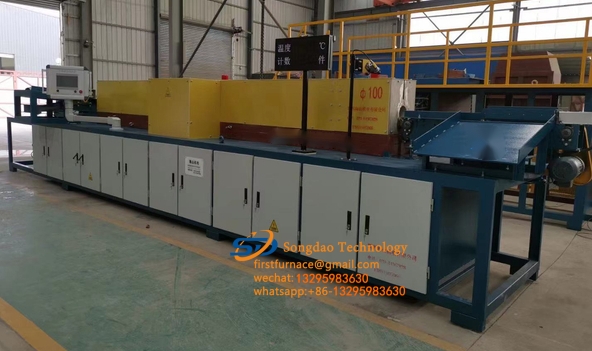- 04
- Nov
Why choose an intermediate frequency furnace?
Why choose an انٹرمیڈیٹ فریکوئنسی بھٹی؟
1. Heating method: The intermediate frequency furnace belongs to electromagnetic induction heating, and its heat is generated by the electromagnetic induction of the workpiece itself; while most of the other heating methods are radiation heating, that is, the furnace is first heated and then the heat is transferred to the workpiece to achieve the purpose of heating the workpiece. In terms of heating methods, the intermediate frequency furnace is better than other heating methods in terms of energy saving, environmental protection and less oxidative burning loss.
2. Heating speed: The electromagnetic heating speed of the intermediate frequency furnace is much faster than that of other furnaces. It does not require furnace heating preparation. The intermediate frequency furnace can be used immediately, and the heating speed can be achieved in a few seconds or tens of seconds. The temperature of the thermal processing process, therefore, the intermediate frequency furnace is better than other heating methods in the heating speed of the workpiece.
3. Degree of automation: The intermediate frequency furnace can be equipped with automatic feeding, temperature measurement system, discharging system, and PLC control to realize heating automation. In particular, round steel heating has become the preferred automatic intermediate frequency furnace heating production line for die forging production lines. Therefore, it is said that automation The high degree is another highlight of the intermediate frequency furnace heating.
4. Energy form: The traditional heating technology is flame heating, gas heating, oil heating, natural coal heating, etc. These energy sources are all non-renewable energy sources. Therefore, for the homeland we rely on, the country advocates environmentally friendly energy. The concept of intermediate frequency furnace heating has gradually replaced the traditional heating method and has become a more popular heating method in the industry.
5. Working environment: The intermediate frequency furnace has a good operating environment and a superior environment, improving the labor environment of workers and the company’s image, no pollution, and low energy consumption. Compared with the coal furnace, the induction heating furnace will no longer be roasted and smoked by the coal furnace under the scorching sun, and can meet the requirements of various indicators of the environmental protection department. Therefore, the working environment of the intermediate frequency furnace is better than other heating methods.
6. Heating quality: the intermediate frequency furnace heats the workpiece with uniform temperature and rapid temperature rise. Under the conditions of temperature conductivity and internal stress, the intermediate frequency furnace can be heated to the predetermined temperature at the fastest speed, increasing the rate, saving energy, and the workpiece is not It will absorb harmful gases, such as oxygen, nitrogen and other gases, reduce defects such as oxidation, decarburization or brittleness, and heat the quality; it will not cause excessive temperature difference between the outer layer and the core of the metal section due to improper heating of the intermediate frequency furnace, so that Excessive thermal stress, and then superimposed other internal stress, causes material rupture.
7. Heating characteristics: the intermediate frequency furnace heats evenly, the temperature difference between the core and the surface is extremely small, and the temperature control accuracy is high. The heat of the intermediate frequency furnace heating is generated in the workpiece itself, so the heating is uniform, and the temperature difference between the core surface is extremely small. The application of the temperature control system can realize the precise control of the temperature of the intermediate frequency furnace and improve the product quality and qualification rate; the intermediate frequency furnace has fast heating speed, high production efficiency, less oxidation and decarbonization, and saves the cost of materials and forging dies

